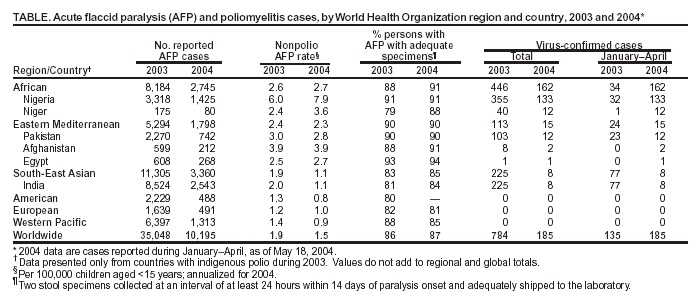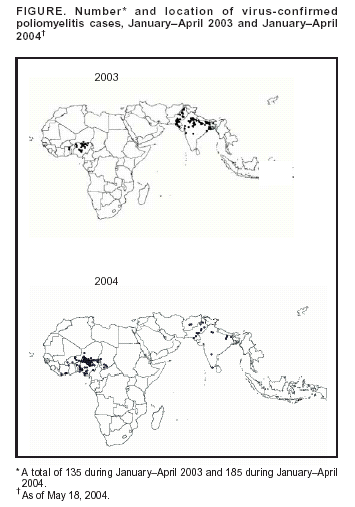 |
|
|
|
|
|
|
| ||||||||||
|
|
|
|
|
|
|
||||
| ||||||||||
|
|
|
|
|
Persons using assistive technology might not be able to fully access information in this file. For assistance, please send e-mail to: mmwrq@cdc.gov. Type 508 Accommodation and the title of the report in the subject line of e-mail. Progress Toward Global Eradication of Poliomyelitis, January 2003--April 2004In 1988, the World Health Assembly (WHA) resolved to eradicate poliomyelitis globally (1). Since then, implementation of the eradication strategies reduced the number of countries with endemic polio from 125 in 1988 to six in 2003 (2). However, in 2003, an unprecedented 10 countries reported poliovirus importations, including eight in West and Central Africa (3), one in Southern Africa (Botswana), and one in the Middle East (Lebanon). This report describes progress made toward global polio eradication during January 2003--April 2004, outlines remaining challenges, and underscores the need for decisive action to interrupt transmission by the end of 2004 or early 2005. Routine VaccinationWorldwide, routine vaccination coverage among infants with 3 doses of oral poliovirus vaccine (OPV3) was estimated at 75% in 2002, compared with 75% in 2001 and 82% in 2000. Coverage varied among World Health Organization (WHO) regions, from 56% in the African Region to 93% in the European Region, with a range in country-level estimates from 25% to 99%. In countries with endemic polio, estimated OPV3 coverage in 2002 was as follows: Egypt, 97%; India, 70%; Pakistan, 63%; Afghanistan, 48%; Niger, 25%; and Nigeria, 25% (4). Supplementary Immunization Activities (SIAs)In 2003, increased SIAs reached 415 million children aged <5 years during 157 SIA rounds conducted in 55 countries. Countries with endemic polio conducted an increased number of national immunization days (NIDs)* and subnational immunization days (SNIDs)† during 2003: four NIDs and two SNIDs in India, four NIDs and four SNIDs in Pakistan, three NIDs and three SNIDs in Afghanistan, four NIDs and three SNIDs in Egypt, and three NIDs and two SNIDs in Niger. In Nigeria, SIAs were conducted in most states; however, SIAs were suspended in certain northern states (e.g., Kano) after March 2003 because of unfounded concerns about OPV safety. Synchronized NIDs were conducted in late 2003 in eight West and Central African countries affected by poliovirus importations, targeting approximately 25 million children aged <5 years. Acute Flaccid Paralysis (AFP) SurveillanceAFP surveillance is established in all countries presently and previously endemic for polio. Two key performance indicators are monitored: 1) the rate of nonpolio AFP cases (target: one or more cases per 100,000 persons aged <15 years); and 2) the proportion of persons with AFP with adequate stool specimens (target: >80%). Globally, the nonpolio AFP rate was 1.9 in 2003 (range by WHO region: 1.2--2.6). The annualized nonpolio AFP rate through April 2004 was 1.5 (range by WHO region: 0.8--2.7). The proportion of persons with adequate specimens for laboratory testing increased from 84% in 2002, to 86% in 2003, and 87% during January--April 2004 (Table). All countries with endemic polio achieved or maintained surveillance quality standards; however, analyses at the subnational level indicate gaps in surveillance. A global network of 145 specialized laboratories supports surveillance activities by testing stool samples for the presence of poliovirus, determining whether the viruses are vaccine-related or wild, and conducting genomic sequencing. Approximately 70,000 stool samples were processed during 2003 in these WHO-accredited, national, regional, and global laboratories. Wild Poliovirus (WPV) IncidenceThe number of polio cases decreased from 1,918 in 2002, to 784 in 2003, and to 185 during January--April 2004§ (Figure). In 2002, a total of 1,600 cases (83% of all global cases) were detected in India; of these, 59% were in children from Muslim communities, which represent approximately 20% of the total population of India. In response to the 2002 epidemic, India intensified SIAs in 2003 and enhanced social mobilization activities to increase acceptance of OPV in all socioeconomic groups. The proportion of Muslim children receiving >3 doses of OPV, as assessed by surveillance data¶, increased from 61% to 85% during 2002--2003. Cases of polio in India decreased from 1,600 in 2002, to 225 cases in 2003, to eight cases during January--April 2004; a total of 77 cases were reported during January--April 2003. In Pakistan, reported cases increased from 90 in 2002 to 103 in 2003. However, transmission during the peak season in the second half of 2003 was lower than in any previous year. Pakistan reported 12 cases during January--April 2004, compared with 23 during the same period in 2003. Afghanistan, which shares a cross-border reservoir of ongoing transmission with Pakistan, reported 10 cases in 2002, eight cases in 2003, and two cases in 2004. Egypt intensified SIAs and increased the proportion of children receiving >5 doses of OPV from 74% to 89% during 2002--2003. One polio case was reported in 2003, compared with seven cases in 2002; the proportion of environmental samples positive for WPV declined from 57% in 2001 to 4% in 2003. No polio cases were reported during January--April 2004. The number of reported cases increased substantially in Nigeria, from 202 in 2002, to 355 in 2003, to 133 in January--April 2004; a total of 32 cases were reported for the same period in 2003. In 2003, Nigeria reported the largest number of cases globally (5). Inadequate SIA coverage and suspension of SIAs in some northern states resulted in intense poliovirus transmission in these areas. This led to the reemergence of polio in previously polio-free areas within Nigeria, and exportation of virus to eight previously polio-free countries in West and Central Africa. The number of reported cases in Niger, which borders Nigeria, increased from three in 2002 to 40 in 2003. During January--April 2004, a total of 12 cases were reported, compared with one for the same period in 2003. Surveillance data indicate that <20% of target age children have received >3 doses of OPV, indicating poor quality of SIAs. In 2003, a total of 51 cases of polio were reported from eight previously polio-free countries in West and Central Africa (Benin, Burkina Faso, Cameroon, Central African Republic, Chad, Ghana, Ivory Coast, and Togo) (3). In 2004, a total of 17 cases have been reported from six of these countries and one in Southern Africa (Botswana). Reported by: Vaccines and Biologicals Dept, World Health Organization, Geneva, Switzerland. Div of Viral and Rickettsial Diseases, National Center for Infectious Diseases; Global Immunization Div, National Immunization Program, CDC. Editorial Note:Substantial progress toward polio eradication was made in 2003, particularly in the Asian and Northern African countries with endemic polio. Only six countries in the world had endemic polio in 2003, the lowest total ever, compared with seven in 2002. Somalia is no longer considered endemic after >1 year without detection of WPV. Egypt, India, and Pakistan recorded their lowest-ever levels of transmission during the second half of 2003, the peak season for poliovirus transmission; levels for January--April 2004 also were record lows. The eradication initiative faced multiple unprecedented obstacles. In Nigeria, several states postponed or canceled SIAs beginning in mid-2003 because of rumors about the safety of OPV. The intense transmission in Nigeria jeopardizes the goal of interruption of poliovirus transmission globally by the end of 2004. For the first time ever, the number (10) of countries reporting poliovirus importations was greater than the number of countries (six) with endemic transmission. The additional control activities in countries with importations resulted in $25 million (U.S.) in unbudgeted costs in 2003. An emergency meeting on polio eradication was convened in January 2004 in Geneva, Switzerland, to develop consensus on increased efforts toward interrupting WPV transmission. On behalf of their nations, health ministers from the affected countries and their polio eradication partners signed the Geneva Declaration to express renewed national and international commitment toward the eradication goal. To interrupt WPV transmission as quickly as possible, countries with endemic polio must intensify polio immunization campaigns throughout 2004, and surveillance standards must be achieved or maintained to ensure rapid detection and response to any importation of polio. On May 17, 2004, at the World Health Assembly, representatives of Afghanistan, Egypt, India, and Pakistan announced accelerated plans to respond to every new case with immediate and widespread vaccination campaigns. Emergency response campaigns in countries of West and Central Africa affected by importations should be extended throughout 2004 and 2005. At their May 2004 meeting, African Union health ministers decided that 22 West and Central African countries should launch emergency synchronized SIAs, targeting 74 million children. These activities will cost an additional $100 million (U.S.) during 2004--2005. The world is almost polio-free. Substantial progress has been made in the majority of countries that remain endemic for polio, increasingly restricting WPV transmission. Governments, health-care workers, volunteers, and international polio partners in all countries where poliovirus is detected must continue to work together to achieve global polio eradication. References
* National or subnational mass campaigns during a limited number of days in which 2 doses of OPV are administered to all children (usually aged <5 years), regardless of previous vaccination history, with an interval of 4--6 weeks between doses † Campaigns similar to NIDs but confined to certain parts of the country. § As of May 18, 2004. ¶ National polio eradication programs analyze the OPV vaccination status (routine and supplemental doses) of children aged <5 years with nonpolio AFP as a proxy for OPV coverage in the general population.
Table  Return to top. Figure  Return to top.
Disclaimer All MMWR HTML versions of articles are electronic conversions from ASCII text into HTML. This conversion may have resulted in character translation or format errors in the HTML version. Users should not rely on this HTML document, but are referred to the electronic PDF version and/or the original MMWR paper copy for the official text, figures, and tables. An original paper copy of this issue can be obtained from the Superintendent of Documents, U.S. Government Printing Office (GPO), Washington, DC 20402-9371; telephone: (202) 512-1800. Contact GPO for current prices. **Questions or messages regarding errors in formatting should be addressed to mmwrq@cdc.gov.Page converted: 6/23/2004 |
|||||||||
This page last reviewed 6/23/2004
|